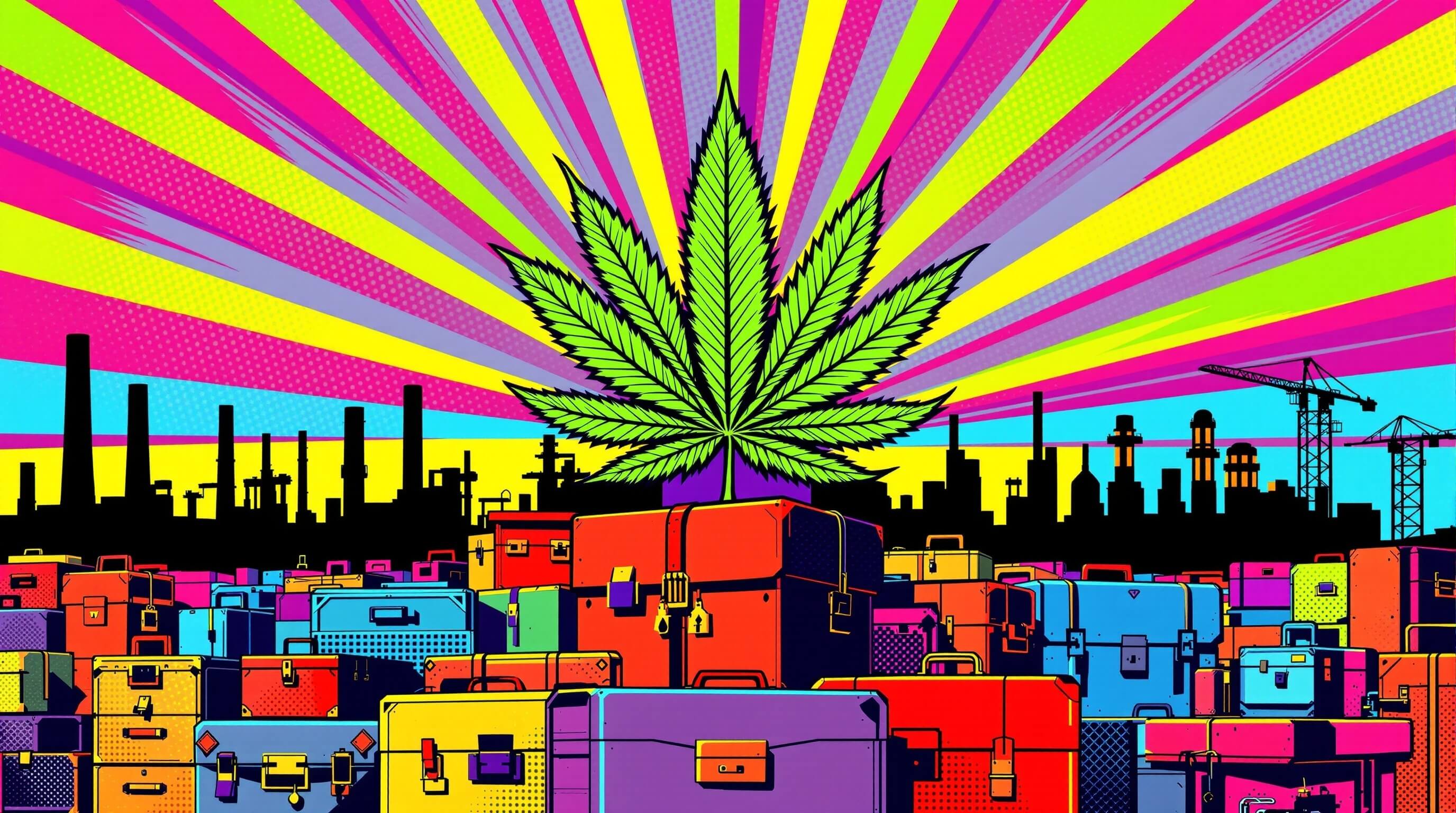Two regions separated by nearly 1,200 miles fundamentally reshaped America’s relationship with cannabis over five decades. Northern California’s Emerald Triangle cultivated the plant’s mystique through legendary strains and outlaw economics during the counterculture era. Denver later transformed that underground legacy into a billion-dollar legal marketplace. These contrasting landscapes, one rural and rebellious, the other urban and regulated created the blueprint for today’s cannabis industry. Yet their opposing philosophies now clash as corporate interests threaten the artisanal traditions that started it all.
The Birth of America’s Cannabis Heartland in Northern California

While mainstream America grappled with the Vietnam War and social upheaval in the late 1960s, a quieter revolution was taking root in the remote hills of Northern California.
The Summer of Love in 1967 catalyzed an exodus from San Francisco’s urban sprawl to the rugged terrain of Humboldt, Mendocino, and Trinity counties. These back-to-the-land pioneers sought self-sufficiency and rejected consumerism.
Countercultural refugees fled urban chaos for California’s remote wilderness, trading city conveniences for radical experiments in communal living and agricultural independence.
The region’s dense forests and geographical isolation provided perfect cover for clandestine cannabis cultivation. The Wiyot, Yurok, and Karuk tribes had thrived in this same landscape for generations, living in harmony with the land that would later become America’s cannabis heartland.
Cannabis quickly evolved from counterculture experiment to economic cornerstone. The area’s unique microclimates and fertile soils produced exceptionally tall plants, some reaching over 15 feet. This isolation fostered the development of close-knit networks among cultivators who relied on trust and mutual support to navigate the challenges of underground growing.
Despite these challenges, cultivators persisted, unaware their work would eventually influence legal frameworks in countries like Canada and Uruguay decades later.
Legendary Strains and the Living Seed Bank of the Emerald Triangle
The Emerald Triangle‘s decades of clandestine cultivation produced more than just a thriving underground economy, it created a genetic goldmine that would reshape cannabis culture worldwide.
Legendary strains like Girl Scout Cookies and Blue Dream emerged from this region’s unique breeding programs. Local growers developed an informal “living seed bank” through generations of knowledge-sharing and genetic preservation.
The region’s microclimates featuring hot days and cool nights naturally boost terpene development. Rolling hills create isolated pockets perfect for experimentation. The area’s unique soil composition works alongside climate conditions to enhance the potency and distinctive characteristics of cultivated strains.
Cultivators selectively bred for aroma, potency, and local resilience while maintaining rare genetics. This collaborative approach produced strains now distributed globally. Many original cultivators and their descendants continue the tradition of cannabis farming, preserving decades of accumulated expertise. These breeders often focused on developing indica hybrids for their faster maturation time and resilience to temperature fluctuations.
Commercial operations across America trace their lineage to Emerald Triangle genetics, earning the region its nickname as cannabis’s “Napa Valley.”
From Counterculture to Community: How Cannabis Built Rural Economies

Dozens of rural communities across America discovered an unexpected economic lifeline when cannabis cultivation transformed from underground rebellion into legitimate enterprise.
Northern California’s cannabis counties alone created over 9,255 full-time jobs in 2022, spanning cultivation to retail operations. The Emerald Triangle exemplifies this dramatic shift, former counterculture havens now host regulated businesses generating $1.26 billion in raw commodity value from 1.8 billion grams harvested.
Personal income per capita rose 2.6% in legalized states, driven largely by cannabis entrepreneurs. Tax revenue flows into education and infrastructure, while property values climb in productive regions like Humboldt County. For every dispensary established, local economic impact multiplies as each $10 spent in cannabis retail generates an additional $18 for surrounding businesses.
Cannabis events and tourism ventures replaced clandestine operations with community-oriented businesses. Labor-intensive cultivation supports both skilled technicians and entry-level workers, creating economic stability that helps offset declining traditional rural industries. The cannabis job market expanded by 445% year-over-year, dramatically outpacing growth in technology and healthcare sectors.
Environmental Footprints and Sustainability Challenges in Remote Growing
As cannabis operations scaled from hidden hillside plots to industrial complexes, environmental concerns emerged as the industry’s most pressing challenge.
Indoor cultivation produces a staggering 2,283 to 5,184 kg of CO₂ per kilogram of dried flower, making it roughly 100 times more carbon-intensive than outdoor growing. The numbers tell a sobering story: U.S. legal cannabis generates up to 10.2 million metric tons of CO₂ annually.
Indoor cannabis cultivation’s carbon footprint dwarfs outdoor growing by 100-fold, contributing millions of metric tons of CO₂ annually to climate change.
Water usage compounds these impacts. Illegal growers consume 83% of the industry’s water, often diverting streams in sensitive habitats where endangered species depend on steady flow. Despite these concerns, cannabis uses dramatically less water than other California crops, consuming just 4 billion liters compared to 8,570 billion liters for orchards alone.
Trespass operations target riparian zones, leaving behind contaminated soil and disrupted ecosystems. Large illicit grow operations cause significant landscape changes including ground cover changes, erosion, new roads, and wetland drainage that permanently alter natural habitats.
The packaging problem adds insult to environmental injury, Canada alone saw 6.4 million kg of plastic cannabis containers hit landfills in a single year.
Colorado’s Legal Revolution and Denver’s Rise as Cannabis Capital

While environmental concerns mounted across traditional growing regions, Colorado blazed an entirely different trail that would fundamentally reshape America’s relationship with cannabis. Amendment 64‘s passage in 2012 transformed Colorado alongside Washington into America’s first recreational cannabis states. The legal framework built upon earlier foundations, medical cannabis legalization in 2000 and decriminalization in 1975 creating a thorough regulatory system.
Denver emerged as the undisputed cannabis capital through strategic positioning and rapid infrastructure development. The city concentrated retail dispensaries, industry associations, and trade shows within its borders. The evolution from the early caregiver model to comprehensive dual licensing scheme regulation demonstrated Colorado’s commitment to structured cannabis commerce.
Legal sales generated a staggering $2 billion annually by legalization’s tenth anniversary. Tax revenues funded education and infrastructure while spurring job growth across cultivation, retail, and testing sectors. States with legal cannabis experienced declining opioid deaths as an unexpected public health benefit.
Research revealed 24% increased usage rates without corresponding crime spikes. Denver’s regulatory innovations influenced national policy models, cementing its leadership role.
Urban Cannabis Culture: Dispensaries, Tourism, and Festival Life
Denver’s legal cannabis framework transformed from regulatory achievement into vibrant urban culture, with dispensaries emerging as neighborhood anchors across the city’s diverse districts.
Overland leads with 13 dispensaries, while Northeast Park Hill, Baker, and Five Points each boast substantial cannabis retail presence. The city now prohibits new licenses in saturated areas, a smart move preventing oversaturation.
Cannabis tourism flourishes through guided dispensary tours, consumption lounges, and cannabis-friendly accommodations. Over 79% of Americans live near dispensaries, yet Denver’s progressive reputation draws visitors seeking immersive experiences.
Major festivals like 4/20 celebrations merge music, art, and consumption, creating economic spikes during event weeks.
Demographics shifted dramatically: more than one-third of women over 21 consume cannabis, while 14% use it for wellness activities. The edibles segment has gained particular popularity with precise dosing requirements making products more accessible to new consumers. Despite the industry’s growth, revenue has dramatically fallen since recreational sales began in 2014, forcing some business closures. Market consolidation pressures continue to challenge smaller dispensaries as larger companies acquire independent operations.
This cultural evolution reflects cannabis integration into mainstream urban lifestyle.
The Great Shift From Artisanal Heritage to Corporate Consolidation
Beyond Denver’s thriving dispensary districts and cannabis festivals, a fundamental transformation reshapes the industry’s economic landscape as corporate consolidation dismantles the artisanal heritage that once defined American cannabis culture.
The numbers tell a stark story. California’s outdoor flower prices have cratered to $300 per pound, while Oregon sits on 3 million pounds of unsold inventory.
Meanwhile, newly regulated states like New Jersey command $2,598 per pound, a staggering 765% premium that attracts deep-pocketed corporations.
Legacy growers in the famed Emerald Triangle face a brutal choice: merge or perish. Multi-state operators systematically acquire distressed assets, replacing regional craftsmanship with standardized products. Despite the industry’s growth potential, cannabis businesses continue struggling with banking challenges that favor well-capitalized corporations over smaller heritage producers.
The cannabis industry supports 440,445 full-time jobs as of early 2024, yet this employment growth increasingly concentrates in corporate-controlled markets rather than traditional heritage regions.
The projected market growth from $33.8 billion to $110.1 billion by 2030 increasingly benefits corporate entities over heritage producers who built cannabis culture.
Preserving Cannabis Traditions in an Era of Mainstream Commercialization
As corporate giants sweep through cannabis markets with industrial efficiency, a quiet revolution unfolds in temperature-controlled facilities and glass-lined curing rooms where heritage cultivators fight to preserve decades of botanical wisdom.
Cryogenic preservation at -196°C safeguards landrace genetics from commercial homogenization, while traditional hang-drying maintains the craft standards that built regional reputations.
Legacy growers still rely on visual cues and glass jar curing, periodically “burping” containers to develop those distinctive flavor profiles that made places like the Emerald Triangle legendary.
Temperature control between 60-70°F and humidity management preserve cannabinoid potency better than rushed industrial methods. The addition of perlite percentage between 20-50% remains a cornerstone technique for soil modification, ensuring optimal aeration for developing plants. Genetic banks now store rare cultivars alongside traditional hash-making techniques. This controlled environment protects against the contamination risks that have historically threatened valuable genetic lines.
Vacuum sealing techniques now complement traditional storage methods, excluding oxygen to prevent the oxidation that would otherwise reduce the potency of carefully preserved heritage strains.
These preservation efforts aren’t just nostalgia—they’re protecting biodiversity and cultural heritage against corporate pressure to standardize everything.
Looking for more? Check out our series on The New Cannabis Culture










